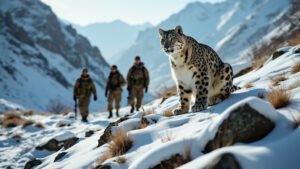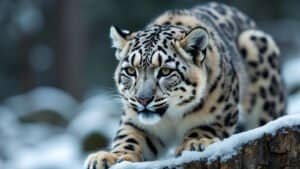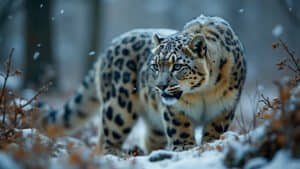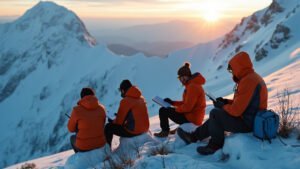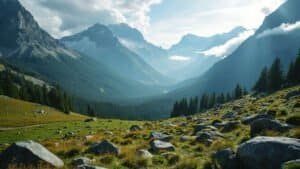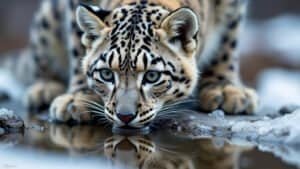Introduction
Involving local people in snow leopard conservation is essential for creating effective and sustainable outcomes. These communities often share their landscapes with snow leopards, making them vital stakeholders in protecting this iconic species
By addressing the economic, social, and ecological needs of local populations, conservation programs can foster coexistence, reduce conflict, and support long-term biodiversity goals
In this article, we explore the many benefits of engaging local communities in snow leopard conservation, including reducing human-wildlife conflict, boosting local economies, and ensuring the health of mountain ecosystems
The Importance of Local Involvement in Snow Leopard Conservation
Involving local communities in snow leopard conservation is a cornerstone of modern conservation strategies. These communities live in close proximity to snow leopard habitats, often directly interacting with the ecosystems that sustain the species
Their inclusion not only enhances the effectiveness of conservation efforts but also ensures that initiatives align with local needs and traditions, fostering a sense of shared responsibility
Why Local Communities Are Key to Conservation Success
Local people are uniquely positioned to contribute to snow leopard conservation because they have an intimate knowledge of the landscapes and wildlife
This knowledge extends to understanding seasonal migration patterns, prey availability, and environmental changes, making them invaluable partners in monitoring and protecting snow leopards
Additionally, snow leopards inhabit remote and rugged terrains that are often challenging for conservation teams to access. By engaging local communities, conservationists gain an extended network of individuals who can observe and report on wildlife activities
Programs like those led by the Snow Leopard Trust highlight how local participation significantly improves the efficiency and coverage of conservation projects
Beyond logistical advantages, involving local communities addresses the social and economic challenges that often drive human-wildlife conflict. For instance, poverty and lack of alternatives may compel herders to retaliate against snow leopards or exploit natural prey species
Including local stakeholders in conservation planning helps address these underlying issues, creating solutions that benefit both people and wildlife
The Connection Between People and Snow Leopard Habitats
The health of snow leopard populations is closely tied to the well-being of local ecosystems, which in turn depend on sustainable land-use practices by the communities living there
Overgrazing by livestock, for example, can deplete vegetation and reduce prey populations, indirectly affecting snow leopards
When communities are actively involved in habitat restoration and sustainable grazing practices, these negative impacts are minimized, leading to healthier ecosystems that support both snow leopards and local livelihoods
Cultural ties between local people and snow leopards also play a significant role. In some regions, snow leopards are revered as sacred or symbolic animals, inspiring traditions that discourage harm to the species. Conservation programs often build on these cultural values to strengthen community support for wildlife protection
By recognizing the interconnectedness of human and ecological systems, conservation efforts that involve local people create a foundation for sustainable and mutually beneficial outcomes
Their involvement not only empowers communities but also ensures the long-term success of conservation initiatives
Reducing Human-Wildlife Conflict Through Local Engagement
Human-wildlife conflict is one of the most significant challenges to snow leopard conservation. When natural prey is scarce, snow leopards often prey on livestock, causing economic losses for herders and sparking retaliatory killings
Engaging local communities in conservation efforts has proven to be an effective way to reduce this conflict and foster coexistence between people and wildlife
Predator-Proof Enclosures and Livestock Insurance
One of the most successful strategies for minimizing human-wildlife conflict is the implementation of predator-proof enclosures. These enclosures are reinforced structures designed to protect livestock from snow leopard attacks, especially during the night when predation is most likely to occur
Built with the support of conservation organizations, these enclosures reduce the financial burden on herders while also safeguarding snow leopards from retaliation
Programs like those initiated by the Snow Leopard Trust have provided hundreds of predator-proof corrals across snow leopard range countries. Studies show that these enclosures can reduce livestock losses by up to 70%, significantly decreasing tension between herders and snow leopards
Livestock insurance programs are another vital tool in reducing conflict. These schemes compensate herders for livestock losses caused by snow leopard predation. By mitigating the economic impact of predation, insurance programs help shift community attitudes toward snow leopards, fostering a sense of coexistence rather than antagonism
For example, in Ladakh, India, insurance programs managed by local communities have successfully reduced retaliatory killings, as herders are no longer forced to bear the financial burden alone
Changing Attitudes Toward Snow Leopards
Education and awareness campaigns play a key role in transforming how communities perceive snow leopards. Historically, snow leopards have often been viewed as threats to livelihoods rather than as valuable components of mountain ecosystems
Conservation programs have worked to change this narrative by emphasizing the ecological importance of snow leopards as apex predators that maintain the balance of their ecosystems
Community outreach initiatives often include workshops, school programs, and cultural events that celebrate the snow leopard as a symbol of pride and heritage. In Mongolia, for instance, the “Snow Leopard Festival” engages local communities in conservation through art, music, and storytelling, fostering positive associations with the species
Conservation organizations also collaborate with local leaders and religious figures to leverage cultural and spiritual values that align with snow leopard protection
In regions where snow leopards are considered sacred, such as parts of Bhutan and Nepal, these partnerships have strengthened community-driven conservation efforts
Empowering Communities to Manage Conflict
By involving local people in the direct management of conflict mitigation measures, conservation programs empower them to take ownership of the outcomes
This sense of empowerment not only enhances the success of conservation initiatives but also builds trust and collaboration between communities and conservationists
For instance, programs like the Snow Leopard Enterprises initiative involve local communities in crafting and selling products such as handicrafts and woolen goods
In exchange for participating, communities commit to protecting snow leopards and reporting poaching activities. This model has been highly successful in reducing conflict while simultaneously improving livelihoods
Through proactive measures like predator-proof enclosures, financial compensation, and community-driven projects, local engagement addresses the root causes of human-wildlife conflict
These efforts create a foundation for coexistence, ensuring that both snow leopards and the people who share their habitats can thrive
Economic and Social Benefits of Conservation Programs
Involving local communities in snow leopard conservation creates opportunities for economic growth and social development. These benefits not only improve livelihoods but also build lasting support for wildlife protection
By aligning conservation goals with the needs of local people, these programs foster a sense of shared purpose that benefits both communities and ecosystems
Generating Income Through Ecotourism
One of the most promising ways to link conservation with economic development is through ecotourism. Snow leopards, often called “ghosts of the mountains,” are a significant draw for wildlife enthusiasts and photographers
Programs that promote sustainable tourism in snow leopard habitats generate income for local communities while raising global awareness about the species
For example, in Hemis National Park, India, community-managed homestays allow tourists to experience the snow leopard’s habitat while contributing directly to local livelihoods. Revenue from ecotourism is often reinvested in conservation initiatives, such as habitat restoration and anti-poaching patrols
By involving locals as guides, trackers, and hosts, these programs create jobs and reduce the economic pressures that drive activities like poaching or overgrazing
Beyond financial benefits, ecotourism also fosters cultural exchange, giving communities an opportunity to share their traditions and stories with visitors. This exchange helps build appreciation for the unique cultural and ecological heritage of snow leopard regions
Sustainable Livelihoods Linked to Conservation
Conservation programs often include alternative livelihood initiatives that reduce reliance on activities harmful to snow leopard habitats
For instance, herders may be encouraged to diversify their income through handicrafts, honey production, or eco-friendly agriculture. These activities provide stable income while reducing overgrazing and habitat degradation, which indirectly benefits snow leopard prey populations
One successful example is the Snow Leopard Enterprises program, which works with herders in Mongolia and other range countries to produce high-quality wool products
Participants receive training and access to markets, increasing their income while committing to conservation principles, such as not harming snow leopards or their prey
Livelihood programs also address gender equity by providing opportunities for women to participate in income-generating activities. In many snow leopard regions, women are responsible for household management and livestock care
Initiatives that empower women to earn income through conservation-related activities strengthen community resilience and support broader conservation goals
Strengthening Community Relationships
Conservation programs often serve as a unifying force within communities, bringing people together to achieve shared goals
For instance, livestock insurance schemes and habitat restoration projects require collective participation, fostering collaboration and trust among community members. These strengthened relationships not only enhance conservation outcomes but also build social cohesion and resilience
Additionally, the recognition and celebration of local efforts in global conservation initiatives provide communities with a sense of pride and accomplishment
This recognition can encourage continued participation in conservation efforts, creating a positive feedback loop that benefits both people and wildlife
Promoting Long-Term Sustainability
Economic incentives tied to conservation provide communities with a vested interest in protecting snow leopards and their habitats. When communities see direct benefits from conservation, they are more likely to support and sustain these efforts over time
Programs that integrate economic and social development with conservation goals ensure that both human and ecological needs are met, creating a foundation for long-term sustainability
By linking conservation with economic growth and social development, these programs demonstrate that protecting snow leopards is not just an ecological necessity but also a pathway to improved livelihoods and stronger communities
Improving Long-Term Conservation Outcomes
Local community involvement is critical for ensuring the long-term success of snow leopard conservation efforts. By empowering communities to take active roles in protecting their ecosystems, conservation programs foster a sense of ownership and accountability that is essential for sustaining progress
These efforts not only benefit snow leopards but also promote healthier ecosystems and resilient local economies
Community-Driven Habitat Restoration Efforts
Habitat restoration is a cornerstone of snow leopard conservation, and local communities play a vital role in its success
Activities such as reforesting degraded areas, managing grazing practices, and protecting water sources contribute to healthier ecosystems that support both prey populations and snow leopards
In many snow leopard range countries, overgrazing by livestock has led to the depletion of vegetation and soil erosion, reducing the availability of food for prey species. Programs that involve herders in rotational grazing and pasture management have proven effective in reversing these trends
For instance, in Kyrgyzstan, community-led initiatives have successfully restored overgrazed areas, leading to a noticeable increase in prey populations and improved snow leopard habitats
Additionally, communities contribute to reducing habitat fragmentation by maintaining wildlife corridors that connect isolated patches of suitable habitat. These corridors enable snow leopards to migrate freely, ensuring genetic diversity and access to prey across their range
By actively participating in these efforts, local people help create landscapes that are conducive to both human and wildlife needs
Building Lasting Relationships Between People and Wildlife
The long-term success of snow leopard conservation depends on fostering positive relationships between local people and wildlife
When communities feel that they are partners in conservation rather than passive recipients of external initiatives, they are more likely to support and sustain these efforts
Education plays a key role in building these relationships. Conservation organizations work closely with schools and community groups to teach the ecological importance of snow leopards and the benefits of biodiversity
These programs often include interactive workshops, field trips, and storytelling, which help create a sense of connection and responsibility toward the natural world
Cultural values also strengthen these relationships. In many regions, snow leopards hold spiritual or symbolic significance, representing qualities such as strength, resilience, and balance. Conservation programs often draw on these cultural narratives to inspire community-led protection efforts
For example, in Bhutan, snow leopards are revered as sacred animals, and this cultural respect has been integrated into national conservation policies
The Role of Local Leadership in Sustaining Conservation
Strong local leadership is essential for maintaining momentum in conservation programs. Community leaders, religious figures, and respected elders often act as advocates for snow leopard protection, helping to mediate conflicts and promote sustainable practices
Their involvement ensures that conservation efforts are grounded in local traditions and values, increasing their acceptance and effectiveness
In addition, training local people as wildlife monitors and conservation officers helps build capacity within communities. These individuals not only contribute to data collection and enforcement but also act as liaisons between conservation organizations and their communities, ensuring that initiatives are responsive to local needs
Ensuring Resilience in the Face of Future Challenges
Local involvement makes snow leopard conservation efforts more adaptable and resilient to future challenges, such as climate change and increasing human development
Communities that are actively engaged in conservation are better equipped to respond to environmental changes, such as shifting prey distributions or habitat loss. Their participation ensures that conservation strategies remain dynamic and effective over time
By integrating local knowledge, fostering positive relationships, and building capacity within communities, conservation programs lay the groundwork for enduring success. These efforts create a legacy of stewardship that benefits snow leopards, ecosystems, and future generations alike
Conclusion
Involving local people in snow leopard conservation is a cornerstone of effective and sustainable wildlife protection. Their intimate knowledge of the landscape, direct interactions with snow leopards, and deep cultural ties to their environment make them indispensable partners in conservation efforts
By reducing human-wildlife conflict, promoting sustainable livelihoods, and empowering communities to take ownership of conservation programs, local involvement ensures long-term success for both snow leopards and the ecosystems they inhabit
The benefits of community-driven conservation extend beyond ecological gains, fostering economic development and social cohesion. From predator-proof enclosures to ecotourism initiatives, these programs address the dual needs of protecting biodiversity and improving human well-being
By integrating local perspectives and empowering communities, conservationists create a foundation for coexistence that supports both people and wildlife
Ultimately, the survival of snow leopards depends on the strength of these partnerships. By working together, local people and conservation organizations can ensure that snow leopards continue to roam the rugged peaks of their mountain habitats, serving as a symbol of resilience and the enduring connection between humans and nature


